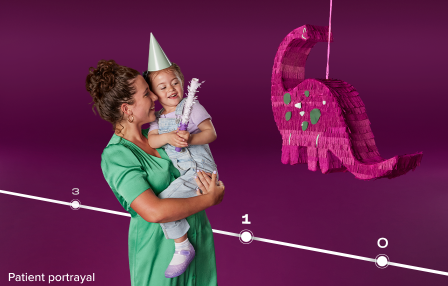—Sami Khella, MD
Professor of Neurology, University of Pennsylvania School of Medicine
Philadelphia, PA
Even stable patients may be struggling with symptoms. Taking a different approach including using the MG-ADL scale to monitor symptoms, aligning on treatment goals with patients, and talking to them about using targeted therapies sooner in conjunction with traditional treatments may help raise the bar on outcomes to help move your patients forward.1-3*

The image above is a patient portrayal and partial depiction of the MG-ADL scale, which assesses the impact of gMG on daily functions of 8 signs or symptoms that are typically affected in gMG. Each function is scored from 0-3: 0 represents normal function and 3 represents the loss of ability to perform that function. A total score can range from 0-24.
*Targeted therapies are treatments that target the underlying pathophysiological pathways of the disease.4
gMG=generalized myasthenia gravis; MG-ADL=Myasthenia Gravis Activities of Daily Living.
Talk to your patients about targeted treatments for gMG sooner—in addition to traditional therapies, they may help your patients get back some of their daily activities that matter most.5-7
Due to the heterogeneity of gMG, patients can feel like their symptoms are always changing. Listening to your patients describe the full picture of their symptoms, as well as their treatment goals, can help ensure alignment on treatment.8
One study of 45 patients found that scores on the Myasthenia Gravis-Quality of Life 15 (MG-QOL15), a self-reported scale designed to assess patients’ quality of life and experience with MG, correlated significantly with the scores on the MG-ADL scale and other clinical evaluation scales at all visits.† A patient with a low total MG-ADL score may still be struggling. In fact, a score of 5 may appear low but can comprise subscores of 2 and 3, indicating a less than normal or complete loss of ability to perform a daily function. Therefore, aiming to decrease even a low total score through treatment strategies may lead to improvement with daily living activities.9-11
†Data was collected from 45 patients who were starting first-time immunomodulatory treatment for MG and did not have other medical conditions that would interfere with treatment with prednisone or IVIG or that the investigator considered important. Pregnant or breastfeeding individuals were excluded.9
gMG=generalized myasthenia gravis; IVIG=intravenous immunoglobulin; MG=myasthenia gravis; MG-ADL=Myasthenia Gravis Activities of Daily Living.
—Sami Khella, MD
Professor of Neurology, University of Pennsylvania School of Medicine
Philadelphia, PA
References: 1. Muppidi S et al. Muscle Nerve. 2022;65(6):630-639. doi:10.1002/mus.27476 2. Mantegazza R, Antozzi C. Front Neurol. 2020;11:981. doi:10.3389/fneur.2020.00981 3. Nair SS, Jacob S. Immunotargets Ther. 2023;12:25-45. doi:10.2147/itt.s377056 4. Sánchez-Tejerina et al. J Clin Med. 2022;11(21):6394. doi:10.3390/jcm11216394 5. Bril V et al. Lancet Neurol. 2023;22(5):383-394. doi:10.1016/S1474-4422(23)00077-7 6. Howard JF Jr et al. JAMA Neurol. 2020;77(5):582-592. doi:10.1001/jamaneurol.2019.5125 7. Howard JF Jr et al. Lancet Neurol. 2017;16(12):976-986. doi:10.1016/S1474-4422(17)30369-1 8. Law N et al. Neurol Ther. 2021;10:1103-1125. doi:10.1007/s40120-021-00285-w 9. Diez Porras L et al. J Clin Med. 2022;11(8):2189. doi:10.3390/jcm11082189 10. Saccà F et al. Eur J Neurol. 2023;30(12):3854-3867. doi:10.1111/ene.15872 11. Wolfe GI et al. Neurology. 1999;52(7):1487-1489. doi:10.1212/wnl.52.7.1487
An argenx representative will contact you soon, so keep an eye on your inbox.
We’re looking forward to sharing information about innovations in gMG with you. Keep an eye on your inbox for important updates on Raising the Bar in gMG.
gMG=generalized myasthenia gravis.